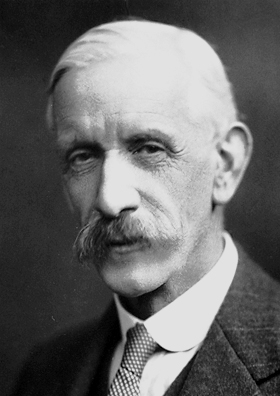Frederick Gowland Hopkins facts for kids
Quick facts for kids
Frederick Gowland Hopkins
|
|
|---|---|
 |
|
| Born | 20 June 1861 Eastbourne, Sussex, England, United Kingdom
|
| Died | 16 May 1947 (aged 85) Cambridge, England, United Kingdom
|
| Nationality | English |
| Education | City of London School |
| Alma mater | King's College London Guy's Hospital |
| Known for | Vitamins, tryptophan, glutathione |
| Awards |
|
| Scientific career | |
| Fields | Biochemistry |
| Institutions | University of Cambridge |
| Academic advisors | Thomas Stevenson Sir Michael Foster |
| Doctoral students | Judah Hirsch Quastel Malcolm Dixon Antoinette Pirie |
| Other notable students | J.B.S. Haldane Albert Szent-Györgyi |
Sir Frederick Gowland Hopkins (born June 20, 1861 – died May 16, 1947) was an English scientist. He was a biochemist, which means he studied the chemical processes happening inside living things.
In 1929, he won the Nobel Prize in Physiology or Medicine. He shared this award with Christiaan Eijkman. They won for their work on discovering vitamins. Vitamins are important substances our bodies need to grow and stay healthy.
Hopkins also found an important building block of proteins called tryptophan in 1901. He led the Royal Society, a famous science group, from 1930 to 1935.
Contents
Early Life and Schooling
Frederick Gowland Hopkins was born in Eastbourne, England. He first went to the City of London School. Later, he moved to Alexandra Park College.
He continued his studies through evening classes at Birkbeck College. He also attended the medical school at Guy's Hospital. This hospital is now part of King's College London.
Discoveries and Scientific Career
After finishing his studies, Hopkins taught about the body and poisons at Guy's Hospital. This was from 1894 to 1898. In 1898, he was asked to join a lab in Cambridge. There, he looked into the chemical side of how the body works.
At that time, biochemistry was not a separate science. In 1900, he became a lecturer at Emmanuel College, Cambridge. He earned a special Master of Arts degree. In 1902, he got a doctorate in physiology from the University of London. He also became a reader in biochemistry at Trinity College.
In 1914, he became the first Professor of Biochemistry at Cambridge University. Some of his students became famous scientists too.
Understanding Cell Energy
Hopkins spent a long time studying how cells get energy. Cells get energy through a complex process of chemical reactions. These reactions involve things being oxidized and reduced.
In 1907, he worked with Sir Walter Morley Fletcher. They studied the link between lactic acid and muscles. They showed that when muscles don't get enough oxygen, lactic acid builds up. Their work helped other scientists understand how muscles get energy.
The Discovery of Vitamins
In 1912, Hopkins published his most famous work. He did experiments feeding animals only pure proteins, carbs, fats, minerals, and water. He found that animals could not grow on this diet alone.
This made him think that normal diets must have tiny amounts of unknown substances. These substances were vital for animals to grow and live. He called them "accessory food factors." Later, these were named vitamins. This important work led to his Nobel Prize in 1929.
Vitamins During Wartime
During World War I, Hopkins kept studying vitamins. His work was very important because food was scarce. He looked into the food value of margarine. He found it was not as good as butter.
This was because margarine lacked vitamins A and D. Because of his research, margarine with added vitamins was made in 1926.
Finding Glutathione
In 1921, Hopkins also found and described a compound called glutathione. He took it from different animal tissues. He first thought it was made of two amino acids.
After more study, in 1929, he figured out it was made of three amino acids. This was the same conclusion another scientist, Edward Calvin Kendall, reached.
Awards and Special Honors
Frederick Hopkins received many awards for his scientific work. In 1924, he was chosen as a Foreign Associate of the National Academy of Sciences in the USA.
Some of his other big awards include:
- The Royal Medal in 1918.
- The Cameron Prize for Therapeutics of the University of Edinburgh in 1922.
- The Copley Medal in 1926.
In 1905, he became a Fellow of the Royal Society. This is a very important science group in Great Britain. King George V made him a knight in 1925, so he became "Sir" Frederick. In 1935, he received the Order of Merit. This is a very special honor in Great Britain.
He was also the president of the Royal Society from 1930 to 1935. In 1933, he led the British Science Association.
Personal Life
In 1898, Frederick Hopkins married Jessie Anne Stephens. They had one son and two daughters. One of his daughters, Jacquetta Hawkes, became a well-known archaeologist.
Sir Frederick Gowland Hopkins passed away on May 16, 1947, in Cambridge. He is buried there with his wife.
See also
 In Spanish: Frederick Gowland Hopkins para niños
In Spanish: Frederick Gowland Hopkins para niños

